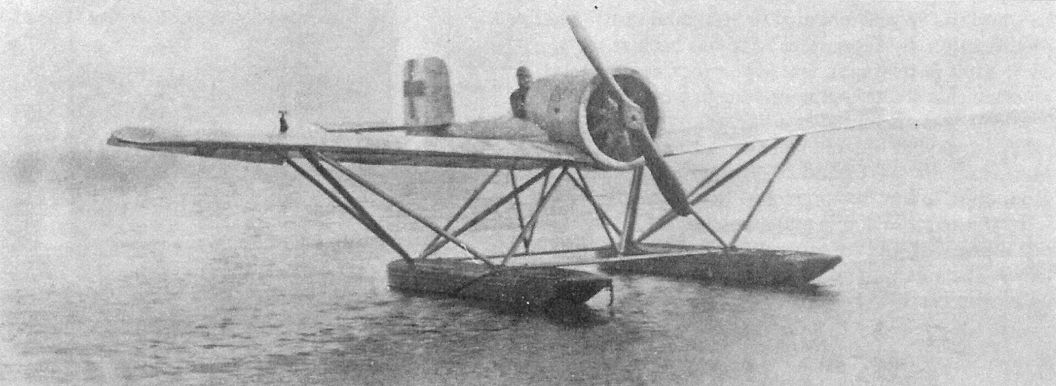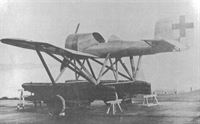O.Thetford, P.Gray German Aircraft of the First World War (Putnam)
L.F.G. Stralsund V 19
Developed at L.F.G. Stralsund during 1918, this sea monoplane was intended to be quickly and easily dismantled and assembled for operation from submarines. However, only a single experimental aircraft was built. Engine, 110 h.p. Oberursel U II.
Показать полностью
J.Herris Roland Aircraft of WWI (A Centennial Perspective on Great War Airplanes 9)
L.F.G. Roland V.19 Putbus
Despite the fact the V.19 never flew operationally, and in fact may never have flown at all, it is interesting both for its intended mission and its technology. As the German Navy gained experience with submarine warfare, the limited range of visibility from a surfaced submarine, typically only about 8 miles (13 km), was noted as a significant tactical limitation. On the other hand, the German surface raider SMS Wolf made a highly successful voyage during which her embarked Friedrichshafen FF33E, Marine Number 841 and nicknamed Wolfchen (Wolf Cub), was very helpful in finding prey. Based on this experience and the need for submarines to detect targets at longer range, the German Navy formulated a requirement for a small spotter aircraft to be carried by a submarine.
The aircraft had to be collapsible to fit in the confined space available on a submarine. It had to be simple enough that untrained men could assemble and disassemble and store it with the minimum of tools. In fact, the requirement allowed only a mallet. The assembly must be foolproof enough that the structure was sound and proper connection of the controls was assured. The role of the aircraft was simply spotting targets, not bombing or strafing, and no air to air combat was envisioned. As a result, and to minimize the size, the aircraft was unarmed and had a single crewman. The Navy suggested an 80 hp rotary engine, eliminating the weight and maintenance problems of a radiator, and required an endurance of two hours so it could patrol effectively out to 120 km from the submarine.
Brandenburg was first to develop such an aircraft, the W20 biplane flying boat of conventional wood and fabric construction. Three prototypes were built and flown before the end of the war, but none were used operationally. Furthermore, their wood and fabric construction was very vulnerable to the elements at sea as Wolfchen had discovered.
The rapid deterioration of Wolfchen during her cruise on Wolf and the intense maintenance required to keep her airworthy, which was not practical aboard a submarine, led the Navy to suggest Dural construction with steel fittings, and L.F.G. therefore chose these materials for their submarine-borne aircraft.
Apparently the V.19 was ordered in July 1918 and construction was completed about the time the war ended; the actual date is unknown. Design and construction were done at L.F.G.'s Abteilung Seeflugzeugbau at Stralsund. The V19 was designed by Gotthard Baatz, who listed the requirements as: 1) quick and easy assembly and disassembly, 2) resistance to seawater, heat, and corrosion, 3) robust construction, 4) assembly and disassembly by a crew of about five men, and 5) seaworthiness in moderate sea states with short takeoff and landing.
All-metal Dural construction was required to meet these requirements, and that was the most technically advanced aspect of the V.19. Its robust, monoplane configuration with thick airfoil was also advanced for its time, when wooden wings using thin airfoils were the norm. The engine is thought to have been a 110 hp Oberursel Ur.II rotary, although other alternatives were mentioned postwar. The fuselage was circular in cross section, and the fuel and oil tanks were located between fire-resistant metal bulkheads aft of the engine. The only part of the V.19 that was wood was its propeller. The wing bracing was clearly inspired by Brandenburg designs, and the aileron controls were automatically connected to the control column when the wings were attached. A strong point on the center of gravity enabled the airplane to be launched and recovered by hoist.
The detachable wings could be folded in three panels spanwise for storage. The entire aircraft was designed to be stored in five waterproof cylinders 70 cm in diameter. Cylinders 1 and 2 were each 4 meters long and each stored a float and long float struts. The fuselage, control runs, and short float struts were stored in Cylinder 5, also 4 m. long. Cylinder 3, 4.5 m long, stored one wing (folded into thirds spanwise) the tailplane, fin, cockpit, and windshield. Cylinder 4, also 4.5 m long, stored the other wing, the rudder, propeller, and elevator. A spare propeller was planned to accompany each airplane.
There is no record of the V.19 being delivered for trails at the SVK (Seeflugzeuge-Versuchs Kommando - Seaplane Testing Command) at Warnemunde or of any Marine Number being assigned. Late completion may be the cause. Postwar the aircraft was named 'Putbus' after the town near Stralsund where it was built.
Baatz claimed the V19 could be unpacked and assembled in 30 minutes and dismantled and packed in 15 minutes, which may have been optimistic in any but the calmest sea state, and would have left th? submarine vulnerable during this time. The engine was to be started before the aircraft was hoisted into the water. The aircraft was too small to carry wireless of the time, and had no navigational aids. The pilot would have had to fly his mission unassisted and return to find the submarine purely by dead reckoning, perhaps the most perilous aspect of the entire concept.
Roland V.19 'Putbus' Specifications
Engine: 110 hp Oberursel Ur.II
Wing: Span 9.56 m
General: Length 6.60 m
Height 2.80 m
Float Track 2.72 m
Empty Weight 480 kg
Loaded Weight 690 kg
Maximum Speed: 170 km/h
Range: 360 km
Показать полностью








